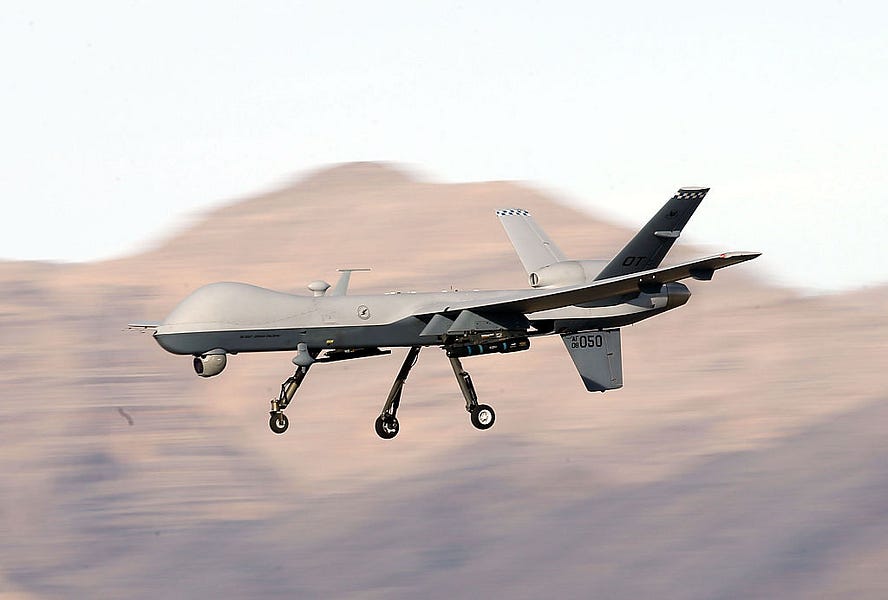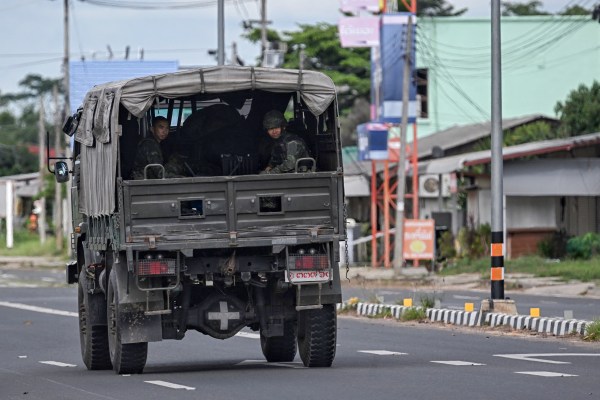On October 7, 2001, a Predator drone armed with an AGM Hellfire laser-guided missile developed specifically for drone missions, was used in a targeted strike against Mullah Mohammed Omar, supreme commander of the Taliban. Instead of striking the facility that Omar was seen walking into, the missile hit a vehicle outside the compound. The strike killed several guards, but the compound was untouched. Before any further action could be taken, Omar and the other Taliban leadership in the vicinity fled. The United States never successfully launched another attack against Mullah Omar; he would eventually die of natural causes in 2013.
On August 29, 2021, in one of its last attacks in Afghanistan, the United States executed a drone strike that killed 10 people. At the time, the strike was lauded as a success—allegedly thwarting an attempted attack on the Kabul airport. Onlookers were told there was one primary target, and nine civilian casualties—collateral damage justified to avoid much greater loss of life if the attack had occurred. However, it soon became clear that American intelligence failed that fateful day. The target posed no provable threat to American security interests in Afghanistan. While the United States has ordered drone strikes in the months since those strikes have been carried out with additional scrutiny from myriad directions.
These bookends of U.S. drone warfare reveal a program enshrined in shadows. The program was launched secretly by the Bush administration after the attacks of 9/11, converting a tool that had been used solely for reconnaissance missions into a weapon that would allow the military to attack targets without risking the lives of American soldiers.
Joe Biden is the fourth president to use drone strikes—officially called targeted killings—but the program was not officially acknowledged until President Obama’s 2013 speech at the National Defense University, when he said: “The United States has taken lethal, targeted action against al-Qaeda and its associated forces, including with remotely piloted aircraft commonly referred to as drones. ”
Reports indicate that Bush carried out only 57 strikes during his presidency. Rough estimates indicate those strikes hit their targets about 60 percent of the time. The Obama administration executed 10 times as many strikes—the official number is 563—with an estimated accuracy of 85 percent. In both cases, the numbers reflect drone strikes outside active war zones, strikes carried out largely in Pakistan, Somalia, and Yemen, rather than places of active hostilities: Afghanistan, Iraq, and Syria.
The official number of targeted killings within war zones is not disclosed by the government. The most comprehensive catalog of drone strikes is maintained by the Bureau of Investigative Journalism, which estimates the Obama administration authorized more than 1,300 drone strikes in Afghanistan alone. According to this report, these strikes resulted in between 2,370 and 3,035 total people killed, with between 124 and 182 civilian casualties over eight years.
These numbers are controversial, particularly among U.S. government officials who allege these numbers are overestimated. But they are difficult to dispute without adequate information provided by the government.
As the use of drones increased significantly, the Obama administration wrestled with the creation of policy guidelines to codify decision-making for direct action, including targeted killings.
In 2013 an unclassified version of the presidential policy guidance (PPG) was released through open records requests. This document outlined “the standard operating procedures for when the United States takes direct action, which refers to lethal and non-lethal uses of force, including capture operations, against terrorist targets outside the United States and areas of active hostilities.”
This guidance applies only to direct action taken outside areas of active hostilities, which are fundamentally different from the decisions that are made regularly by military commanders. As a senior Obama administration official explained, the military operates using different rules of engagement within war zones, and while they shouldn’t be all that dissimilar to other strikes, military commanders have a duty to mitigate any threats to their forces.
Standard operating procedures within war zones remain largely classified. The U.S. government does not release official numbers of targeted killings or casualties—civilian or combatant.
Obama’s PPG asserted that targeted killings (outside war zones) could be executed only when there was “near certainty” of both the identity of the target and that the strike could be executed without “injuring or killing non-combatants.”
In a move toward greater transparency, President Obama issued Executive Order 13732 in July 2016, requiring the director of national intelligence (DNI) to collect the number of strikes outside of areas with active hostilities, as well the number of deaths of both combatants and non-combatants to be released in an unclassified report annually.
In concert with this order, the Obama administration released its report for strikes outside of areas of active hostilities between January 20, 2009, and December 31, 2015. According to the DNI, 473 strikes were ordered, resulting in between 2,372 and 2,581 combatant deaths, and between 64 and 116 non-combatant deaths. The 2016 summary report indicated the U.S. executed 53 strikes, resulting in between 431 and 441 combatant deaths, and only one civilian casualty.
That is the last year for which we have publicly available data from the United States government. The DNI did not release the reports for 2017 or 2018, and President Trump officially revoked the executive order in 2019.
The policy guidance from the Trump administration was released in May 2021 in response to open records requests. It showed the Trump administration maintained the “near certainty” standard. However, the New York Times reported that Biden administration officials “discovered that Trump-era principles to govern strikes in certain countries often made an exception to the requirement of “near certainty” that there would be no civilian casualties. It kept that rule for women and children, but permitted a lower standard of merely “reasonable certainty” when it came to civilian adult men.
According to external counts from the Bureau of Investigative Journalism, the number of targeted killings grew significantly during the Trump presidency. Targeted killings outside of war zones remained largely similar to past trends—estimations suggest about 340 strikes during Trump’s four years in office. However, estimates indicate a tenfold increase in strikes executed in Afghanistan—nearly 11,761 according to the Bureau of Investigative Journalism. This estimate indicates that between 1,727 and 6,976 people were killed, with an unknown number of civilian casualties.
The Trump administration released no official data regarding targeted killings.
Every targeted strike operation must be approved by the president and a lawyer. This typically involves determining the individual legality of each strike. While the overall operation must have the president’s seal of approval, agencies do not need further approval to execute individual strikes. When there are disagreements among leadership, decisions are brought back to the president.
Depending on which agency was executing the strike (chiefly CIA or military), it was their lawyer’s interpretation that mattered most. While policies may be shifted depending on who sits in the Oval Office, legal standards do not change. However, interpretations of the law certainly change. Presidents appoint their own attorneys general, and with that, they invite a particular legal lens into the conversation.
This lends itself to remarkably murky understandings of who can be targeted by these strikes. The United States authorized a targeted killing against an American citizen abroad, and an assassination-by-drone against a member of a foreign government. These are unique—most drone strikes are carried out against illegitimate actors (members of terrorist organizations, non-state actors). But they outline the liminal legal space in which drones exist.
Today the MQ-1 Predator drone has been retired, replaced by the MQ-9 Reaper—a faster aircraft equipped with more accurate sensors, and the ability to travel with more munitions. Unlike the Predator, the Reaper was initially designed and manufactured for combat, making it a more effective tool in the military’s arsenal. With these updates, the explosive footprint of these weapons is more precise.
When aimed at an accurate target, drones are capable of executing a strike on a single room in a house—leaving the rest of the house standing, and the neighborhood otherwise untouched.
As this technology further develops, leadership gains access to increasingly precise weapons of war. The hope of practitioners is that while the technology develops, it will be used judiciously to reduce civilian casualties, not increase them through haphazard use.
One thing seems to be certain: Drone strikes will continue to be used. The military announced in late October that a U.S. drone strike in Syria took out Abdul Hamid al-Matar, a senior al-Qaeda leader.






Please note that we at The Dispatch hold ourselves, our work, and our commenters to a higher standard than other places on the internet. We welcome comments that foster genuine debate or discussion—including comments critical of us or our work—but responses that include ad hominem attacks on fellow Dispatch members or are intended to stoke fear and anger may be moderated.
With your membership, you only have the ability to comment on The Morning Dispatch articles. Consider upgrading to join the conversation everywhere.